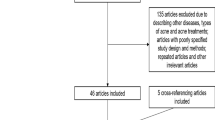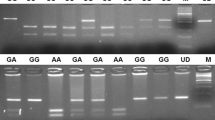Summary
In this case-control study, the relationship between M196R (676 T→G) variant in exon 6 of tumor necrosis factor receptor type 2 ( TNFR2 ) gene and genetic susceptibility of acne vulgaris in Han Chinese was investigated. A total of 93 acne vulgaris patients and 90 healthy subjects from Han Chinese ethnic group were enrolled in this study. Polymerase chain reaction-restriction fragment length polymorphism (PCR-RFLP) technique was adopted to analyze the single nucleotide polymorphisms (SNPs) of TNFR2 M196R gene, and to examine the association between acne vulgaris and the polymorphisms in TNFR2 M196R gene. The relationship between different genotypes and the susceptibility of acne vulgaris was analyzed. The results showed that there was significant difference in the frequency of the genotype M/R+R/R in the TNFR2 M196R genetic polymorphisms between acne vulgaris patients and healthy controls (χ2=4.343; P=0.037; OR=1.899; 95% CI: 1.036–3.445); and there was significant difference in the allele (R) frequency between acne vulgaris patients and healthy controls (χ2=5.588; P=0.018; OR=1.838; 95% CI: 1.105–3.057). It was concluded that the high frequency of 196R allele in the functional M196R polymorphism of TNFR2 is a risk factor for acne vulgaris in Han Chinese.
Similar content being viewed by others
References
Uhlenhake E, Yentzer BA, Feldman SR. Acne vulgaris and depression: a retrospective examination. J Cosmet Dermatol, 2010,9(1):59–63
Wei B, Pang Y, Zhu H, et al. The epidemiology of adolescent acne in North East China. J Eur Acad Dermatol Venereol, 2010, [Epub ahead of print], PMID: 20337811
Xu SX, Wang HL, Fan X, et al. The familial risk of acne vulgaris in Chinese Hans—a case-control study. J Eur Acad Dermatol Venereol, 2007,21(5):602–605
Bhambri S, Del Rosso JQ, Bhambri A. Pathogenesis of acne vulgaris: Recent advances. J Drugs Dermatol, 2009,8(7): 615–618
Plewig G. How acne vulgaris develops. Hautarzt, 2010,61(2):99–100
Zaidi Z. Acne vulgaris-an update on pathophysiology and treatment. J Pak Med Assoc, 2009,59(9):635–637
Kurokawa I, Danby FW, Ju Q, et al. New developments in our understanding of acne pathogenesis and treatment. Exp Dermatol, 2009,18(10):821–832
Youn SW. The role of facial sebum secretion in acne pathogenesis: Facts and controversies. Clin Dermatol, 2010,28(1):8–11
Isard O, Knol AC, Castex-Rizzi N, et al. Cutaneous induction of corticotropin releasing hormone by Propionibacterium acnes extracts. Dermatoendocrinol, 2009,1(2):96–99
Elahi MM, Asotra K, Matata BM, et al. Tumor necrosis factor alpha-308 gene locus promoter polymorphism: An analysis of association with health and disease. Biochim Biophys Acta, 2009,1792(3):163–172
Kim J. Review of the innate immune response in acne vulgaris: Activation of Toll-like receptor 2 in acne triggers inflammatory cytokine responses. Dermatology, 2005,211(3):193–198
Tenaud I, Khammari A, Dreno B. In vitro modulation of TLR-2, CD1d and IL-10 by adapalene on normal human skin and acne inflammatory lesions. Exp Dermatol, 2007,16(6): 500–506
Trivedi NR, Gilliland KL, Zhao W, et al. Gene array expression profiling in acne lesions reveals marked upregulation of genes involved in inflammation and matrix remodeling. J Invest Dermatol, 2006,126(5): 1071–1079
Caillon F, O’Connell M, Eady EA, et al. Interleukin-10 secretion from CD14+ peripheral blood mononuclear cells is downregulated in patients with acne vulgaris. Br J Dermatol, 2010,162(2):296–303
Baz K, Emin Erda M, Yazici AC, et al. Association between tumor necrosis factor-alpha gene promoter polymorphism at position -308 and acne in Turkish patients. Arch Dermatol Res, 2008,300(7):371–376
Peral B, San Millan JL, Castello R, et al. The methionine 196 arginine polymorphism in exon 6 of the TNF receptor 2 gene (TNFRSF1B) is associated with the polycystic ovary syndrome and hyperandrogenism. J Clin Endocrinol Metab, 2002,87(8):3977–3983
Oregón-Romero E, Vázquez-Del Mercado M, Navarro-Hernández RE, et al. Tumor necrosis factor receptor 2 M196R polymorphism in rheumatoid arthritis and osteoarthritis: Relationship with sTNFR2 levels and clinical features. Rheumatol Int, 2006,27(1):53–59
Horiuchi T, Kiyohara C, Tsukamoto H, et al. A functional M196R polymorphism of tumour necrosis factor receptor type 2 is associated with systemic lupus erythematosus: A case-control study and a meta-analysis. Ann Rheum Dis, 2007,66(3):320–324
Tian L, Hu Y. Correlation between CAG polymorphisms of androgen receptor gene and the acne cystica of Han Chinese. Beijing Med (Chinese), 2009,31(2): 97–100
Ruchhaus M, Gross M, Schulz S, et al. The E-selectin SER128ARG gene polymorphism and restenosis after successful coronary angioplasty. Int J Cardiol, 2002,83(3):249–257
Glossop JR, Dawes PT, Nixon NB, et al. Polymorphism in the tumour necrosis factor receptor II gene is associated with circulating levels of soluble tumor necrosis factor receptors in rheumatoid arthritis. Arthritis Res Ther, 2005,7(6):R1227–R1234
Kang S, Cho S, Chung JH, et al. Inflammation and extracellular matrix degradation mediated by activated transcription factors nuclear factor-κB and activator protein-1 in inflammatory acne lesions in vivo. Am J Pathol, 2005,166:1691–1699
Kao M, Huang CM. Acne vaccines targeting Propionibacterium acnes. G Ital Dermatol Venereol, 2009, 144(6):639–643
Sugita T, Miyamoto M, Tsuboi R, et al. In vitro activities of azole antifungal agents against Propionibacterium acnes isolated from patients with acne vulgaris. Biol Pharm Bull, 2010,33(1):125–127
Zaenglein AL. Making the case for early treatment of acne. Clin Pediatr (Phila), 2010,49(1):54–59
Batista Júnior ML, Lopes RD, Seelaender MC, et al. Anti-inflammatory effect of physical training in heart failure: role of TNF-alpha and IL-10. Arq Bras Cardiol, 2009,93(6):643–651,692–700
Puga I, Lainez B, Fernández-Real JM, et al. A polymorphism in the 3′ untranslated region of the gene for tumor necrosis factor receptor 2 modulates reporter gene expression. Endocrinology, 2005,146(5): 2210–2220
Gottenberg JE, Busson M, Loiseau P, et al. Association of transforming growth factor β1 and tumor necrosis factor alpha polymorphisms with anti-SSB/La antibody secretion in patients with primary Sjögren’s syndrome. Arthritis Rheum, 2004,50(2):570–580
Author information
Authors and Affiliations
Corresponding author
Additional information
This project was supported by grants from the Scientific Research Foundation of Hunan Provincial Health Office (No. 2006-238), and the Scientific Research Foundation of Hengyang City of Science and Technology Agency (No. 2008KS003).
Rights and permissions
About this article
Cite this article
Tian, L., Xie, H., Yang, T. et al. TNFR 2 M196R polymorphism and acne vulgaris in Han Chinese: A case-control study. J. Huazhong Univ. Sci. Technol. [Med. Sci.] 30, 408–411 (2010). https://doi.org/10.1007/s11596-010-0366-z
Received:
Published:
Issue Date:
DOI: https://doi.org/10.1007/s11596-010-0366-z




